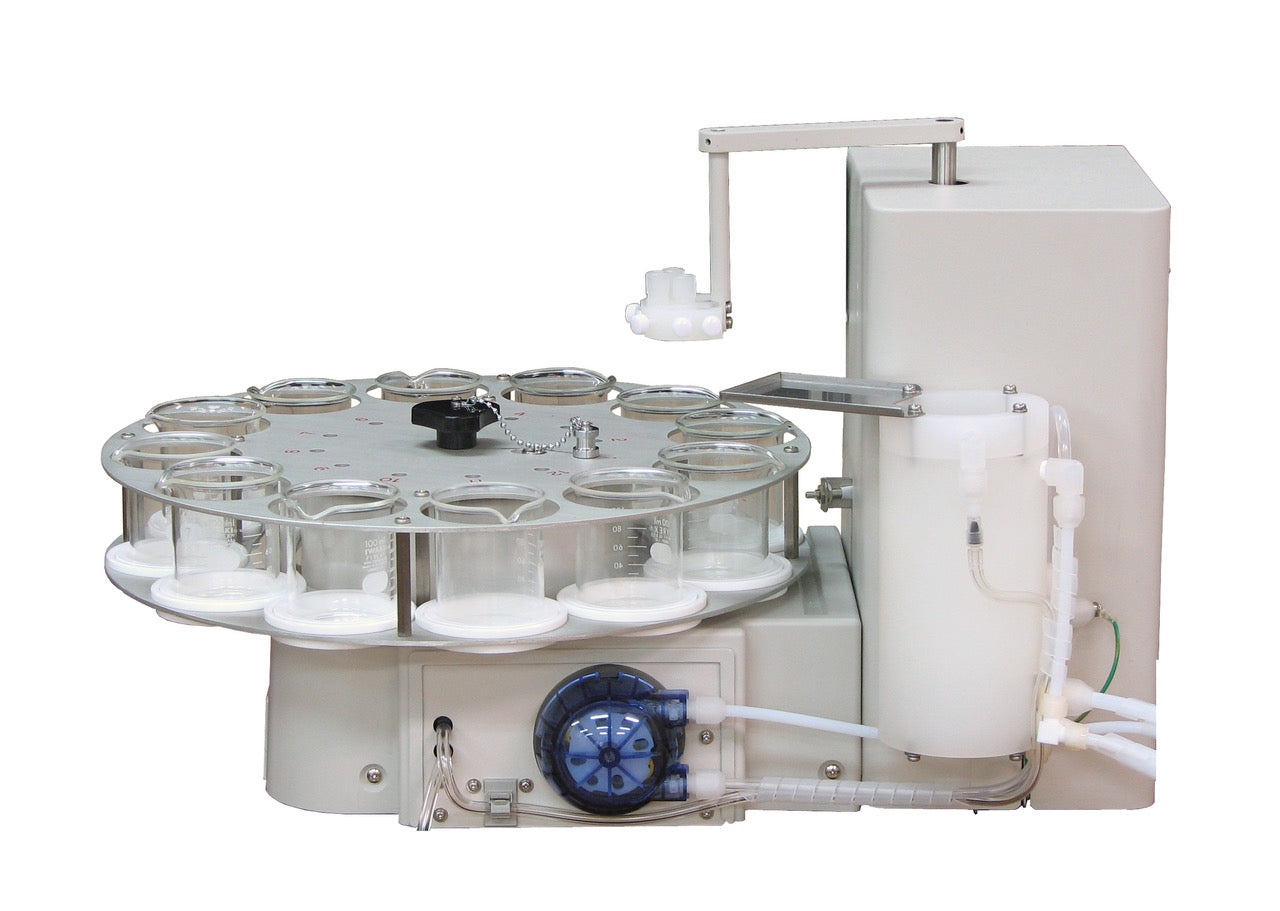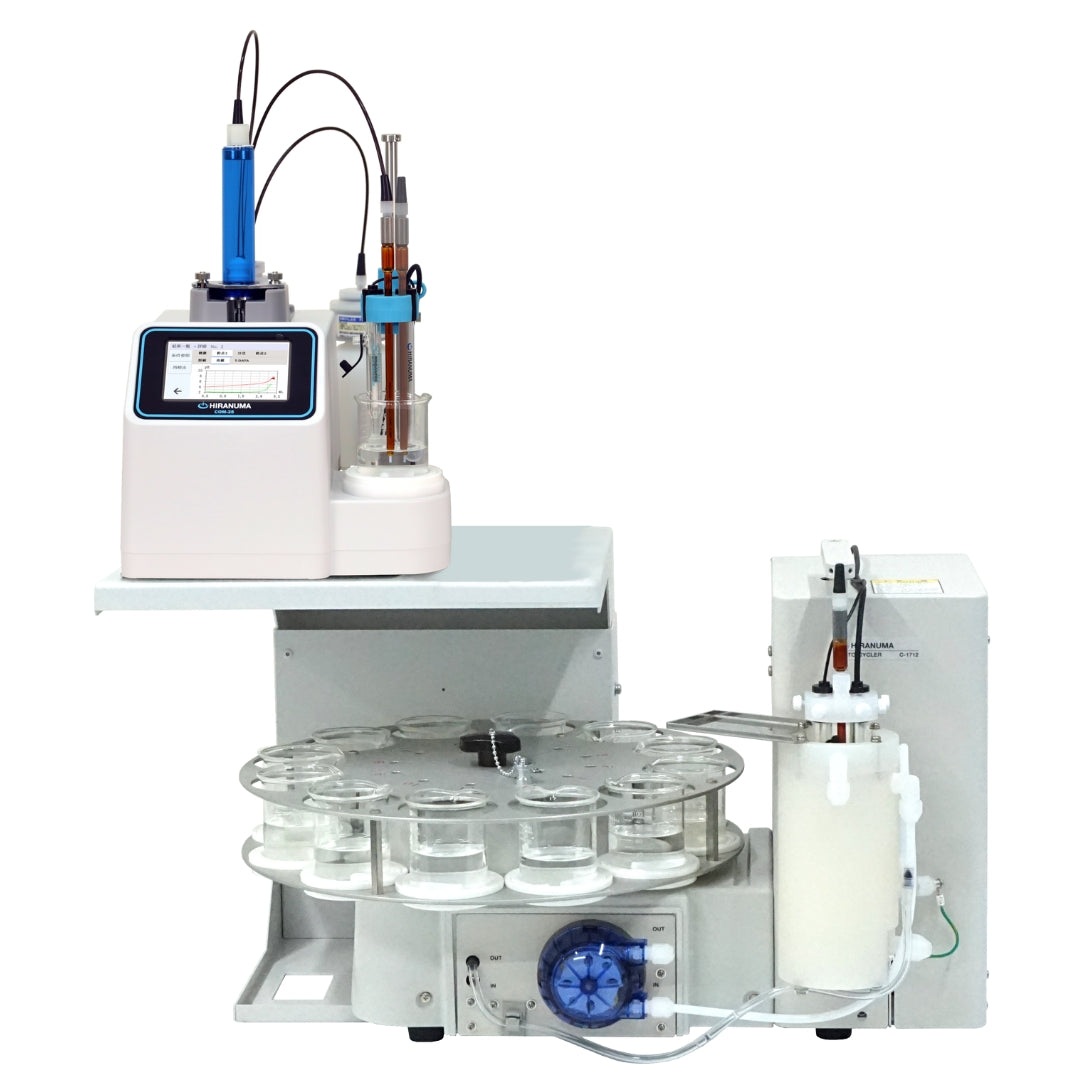| HIRANUMA APPLICATION DATA | Automatic Titrator | Data No. | B20 | Nov. 14,2018 |
| Drugs and Medicines | Standardization of perchloric acid in acetic acid with potassium hydrogen phthalate |
1. Abstract
Measurement method with perchloric acid – acetic acid standard solution is defined as a quantitative determination method for each drug and medicine in Japanese Pharmacopoeia. Standardization of perchloric acid – acetic acid standard solution with potassium hydrogen phthalate is also described there. This report introduces the standardization procedure that potassium hydrogen phthalate is dissolved in acetic acid, then it is titrated with perchloric acid – acetic acid standard solution. The factor of perchloric acid – acetic acid standard solution is determined with potentiometric titration. 1 mol potassium hydrogen phthalate reacts with 1 mol perchloric acid quantitatively on this titration (formula 1).
 ・・・(1)
・・・(1)2. Configuration of instruments and Reagents
| (1) | Configuration of instruments | ||
| Main unit | : | Hiranuma Automatic Titrator COM Series | |
| Electrodes | : | Glass electrode GE-101B** | |
| : | Reference electrode RE-201Z* *Inner solution has to be changed to saturated sodium perchlorate in acetic acid. **Glass-reference combination electrode GR-511BZ is also usable. |
||
| (2) | Reagents | ||
| Titrant | : | 0.1 mol/L perchloric acid – acetic acid standard solution | |
| Titration solvent | : | 50 mL of acetic acid (reagent grade) | |
| Standard sample | : | Potassium hydrogen phthalate (volumetric standard) | |
| Inner solution | : | Saturated sodium perchlorate in acetic acid | |
3. Measurement procedure
| (1) | Take about 0.3 g of potassium hydrogen phthalate into 100 mL beaker and weigh accurately to 0.1 mg digits. |
| (2) | Add 50 mL of acetic acid and dissolve sample by heating and stirring. After that, cool it down to room temperature. |
| (3) | Immerse the electrodes and titrate with 0.1 mol/L perchloric acid – acetic acid standard solution. Additionally, perform the blank test with the same procedure of sample measurement. |
4. Measurement conditions and results
Examples of titration conditions
Measurement of blank

Measurement of potassium hydrogen phthalate

* Factor = (Purity of potassium hydrogen phthalate (%)/100)
Measurement results
Measurement of blank
| Number of Measurement |
Size (g) |
Titrant volume (mL) |
|---|---|---|
| 1 | – | 0.010 |
| 2 | – | 0.010 |
| Avg. (Blank) |
0.010 mL | |
Measurement of potassium hydrogen phthalate
| Number of Measurement |
Size (g) |
Titrant volume (mL) |
Factor |
|---|---|---|---|
| 1 | 0.2908 | 14.271 | 0.9983 |
| 2 | 0.3068 | 15.061 | 0.9979 |
| 3 | 0.2956 | 14.526 | 0.9969 |
| Statistic calculation |
Avg. SD RSD |
0.9977 0.001 0.072 % |
|
Examples of measurement curves
|
|
|
5. Note
| (1) | Effect of water on perchloric acid titration Water mixed in a measurement system affects to the reaction system of perchloric acid titration because of the leveling effect, which results in a negative effect such as lowered quantitative performance or getting less sensitivity around the end point. Therefore please take care not to mix water in the measurement system. Reference electrode for non-aqueous titration should be prepared as described in the following item (2), because water of KCl solution commonly used as inner solution for reference electrode could be mixed in the measurement system. |
||||||||
| (2) | Preparation of inner solution for reference electrode The inner solution of the reference electrode RE-201Z is filled with 4 M KCl aqueous solution when purchased. This inner solution have to be replaced to saturated sodium perchlorate in acetic acid solution for this measurement. Replacement procedure is described below.
|
||||||||
| (3) | Influence of experiment temperature on perchloric acid titration Acetic acid used as a solvent for the titrant has a relatively large thermal expansion coefficient. When the temperature changes by 1 °C, the titrant causes a volume change of 0.1 %. Factor titration and sample measurement should be performed at the same room temperature as much as possible for accurate measurement. (Please refer to application data B19 in regards to factor correction.) |
| Keywords: | Drugs and medicines, Japanese pharmacopoeia, Perchloric acid titration, Standardization, Non-aqueous titration, Potassium hydrogen phthalate |
*Some measurement would not be possible depending on optional configuration of system.











